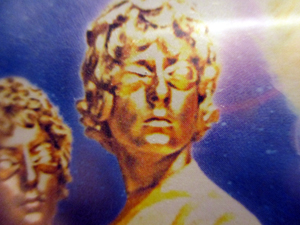The Claws of Axos
“All things must die, Doctor—mankind, this planet–Axos merely hastens the process.” – Axon
The concepts of this story are good and interesting sci-fi—an organic spaceship, beings and objects that end up all being part of one organism, a seemingly beautiful golden people offering gifts who later turn out to be amorphous blobs seeking to feed parasitically off the life of earth. These ideas are why the story was enjoyable to me as a novel when I first encountered as a youngster. Unfortunately, there are a lot of bad effects, stilted dialogue and acting, and bad direction that undermine the good base ideas.
While a lot of the costuming and effects issues could have been solved with some different and more subtle camera angles, there are also some basic issues with the story telling. It’s a rather simplistic and caricatured in its treatment of people and situations. The complexities of international negotiations and the logistics of worldwide distribution of a product are glossed over to the point of absurdity, little more than a phone call. Of course, the story is trying to make a point about greed being humanity’s downfall so I at least appreciate that. There are also many instances where we have to make assumptions of things that happened or a leap to a conclusion without it being within the story. At the ending for example, Jo and the Brigadier must have discussed that they didn’t really believe the Doctor betrayed them such that they were expecting and look forward with concern to him returning. Unfortunately, the story doesn’t mention this so it looks like they simply forgot what happened to them just a few minutes earlier.
As for characters, some of them come off cartoonish for children like the bumbling vagrant on his bike. There is also Chinn the self-important yet incompetent and greedy old bureaucrat whose superiors even hold him in disdain. He’s written in such a way that we’re supposed to hate him, but he really just comes off rather sad as his obvious insecurity is exposed. I would say that the scene where he takes over a military operation without any ability to actually do so and the Doctor has to remind him first subtly (“What comes up must come down”) and finally bluntly (“Abort, man, abort!”) to destroy a launched missile before it falls back to earth is unrealistic—but then again recent years in US politics have proven inept people can become leaders. At least there are several fun moments of how people handle him—like the Brigadier smoothly telling Yates to let Chinn use the important “direct line” for phoning when there is obviously not one, just the fact that it’s in another room out of the way. Or when Chinn asks the mister if he needs to scramble their phone call and the minister replies: “Just your report, Chinn. I’m sure that will be quite garbled enough.” Ouch!
We’re also supposed to immediately like Bill Filer (like Jo who seems to fall in love with him at first glance) just for being the grizzled American agent with his casual slang and demeanor, but his dialogue and delivery seem very fake. I was initially perturbed that they even had an American agent suddenly turn up interested in the Master for what seemed like no reason, but then I remembered in the last episode the American diplomat was killed so it actually makes sense and is a nice bit of continuity in the narrative that Filer would be there.
The Master comes across a little wimpy having escaped last episode only to end up captured by Axos in this one, but his jump onto the UNIT lorry and hanging onto the side as he looks at the driver through the mirror to hypnotize him is pretty cool. As for the main villains the Axons, the trippy organic ship is hit-and-miss in terms of design—some of it looks good while other parts of it look like low-budget curtains. Much of the design is an attempt at being super-psychedelic. The golden Axons are done well but unfortunately the “spaghetti monsters” look a bit silly, especially when not in their own context. Their walk down the steps of the power complex just looks awkward. At least the Doctor’s has a new found freedom of sorts in the TARDIS (“a galactic yoyo”) that will allow us to move to some space-based stories.
Best unsettling moments:
While many of the camera attempts at weird psychedelic effects fall short, there are a few that hit the odd button in just the right way. One is the doubling of Bill Filer. The other is the face of the Axon head that speaks to the Doctor and Jo in the control room—while the conversation remains steady the image keeps rotating but also reforming in a way that is both disorienting and creepy.
Firsts:
- Giant eye stalk in a space ship
- New TARDIS interior (the first of many redesigns)
Regrets:
There are a lot of unfortunate special effects (the blob that the scientist turns into for example) but some additions are also just unnecessary like the overuse of a flash dissolve on the screen. The collapsing face on the vagrant’s body would have been good enough of a shot alone—the sudden dissolve to white actually ruins the effect. Similarly on Jo’s aging transformation as well.
And why do they ruin the surprise of the true nature of the Axons by showing them ahead of time in the opening shots of the story?

